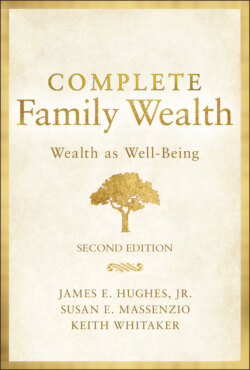Читать книгу Complete Family Wealth - Keith Whitaker, James Hughes E., James E. Hughes Jr. - Страница 38
The Three-Circle Model
ОглавлениеSo far, we have discussed wealth and family. When a family has the intention to work together over generations to grow all its forms of capital, it creates a combination that we call family enterprise.
Enterprise is a business term. But families do not have to own and manage a business to be enterprising. Many of the enterprising families we know sold their operating businesses years or generations ago.
The first key to leading a family enterprise well is to recognize that it is composed of different parts that, as closely connected as they are, have different goals and different ways of operating.
The three main parts of any family enterprise are family, owners, and management. Family is the family of affinity. Owners include all those who own title to family capital, whether they are individuals, boards of directors, or trustees and beneficiaries of family trusts. Management can include the managers of a family-owned or controlled business, financial managers of family assets, and the advisers to the managers, owners, and family members (such as attorneys and accountants).
These parts—family, owners, and management—are at the heart of one of the most helpful models for family enterprise ever developed: the “Three-Circle Model” developed originally by Renato Tagiuri and John Davis of Harvard University (see Figure 2.1).
The Three-Circle Model is helpful in many ways.
First, it underscores that while the three circles of family enterprise form one system, each circle has its own priority. For family, that is inclusion. For ownership, it is preservation (e.g., minimizing income or transfer taxes or shielding assets from potential creditors). For management, it is performance.
FIGURE 2.1 The Three-Circle Model.
Source: Based on John Davis and Renato Tagiuri, 1996.
Troubles arise when the priority from one circle dominates the others. For example, the desire to preserve assets may keep ownership very limited, such as by excluding spouses. Likewise, management may want to improve performance by keeping “unprofessional” family members and owners at arm's length. And ownership and management may conflict over the amount of risk to take on in the pursuit of outsized returns.
Second, the model helps family enterprises locate the proper points at which to understand and resolve common conflicts. Some of the most common conflicts and challenges that arise in family enterprises include:
Parent-child and sibling conflict over managerial control.
Conflicts over managerial strategy and direction.
Conflicts over ownership strategy (e.g., keep vs. sell).
Conflicts between shareholders who are also managers versus shareholders who are outside the business, for example, over whether to reinvest profits or distribute them as dividends.
Conflicts over employment and compensation of family members.
Tensions between the spouses of family members who are owners or managers in the business.
Failure of communication and understanding between trustees (family or nonfamily), the legal owners of title, and beneficiaries—especially when, by the third generation, most, if not all, of the family's financial capital may be held in trust.
Most of these conflicts arise when people do not acknowledge the overlaps among the three circles. The starting point for resolving these conflicts is to acknowledge the different factors in them: the family needs, the needs of management, and the needs and responsibilities of owners.
Another helpful feature of the Three-Circle Model is that it gives enterprising families a way to visualize and understand where they are putting most of their efforts—and what areas they may be ignoring.
Imagine that the size of each circle represents the amount of time and care that your family enterprise devotes to family, ownership, and management. Which circles get bigger and which get smaller?
For example, is the management of an operating business or the management of the family's financial capital what occupies the most time and attention? If so, then your diagram may look more like Figure 2.2.
Or does your family enterprise focus most on who owns which shares and who elects directors? Do you spend most of your time and care on estate planning and its various structures? If so, then perhaps your diagram looks like Figure 2.3.
FIGURE 2.2 The reality for many family enterprises.
FIGURE 2.3 When ownership is the priority.
These two variations on the Three-Circle Model are the most common. It is not at all rare for either the management circle or the ownership circle to dwarf the other two. In both cases, the family circle gets smaller and smaller. If that is the case in your family, then your task is evident: to try to do what you can to grow that family circle. Ideally, for long-term success, the family circle should be larger than the other two, not smaller (see Figure 2.4).
By growing the family circle, you ensure that your family members have ways of connecting and spending time together apart from business or wealth management. You will also lay the foundation for communicating appropriate information about the financial capital broadly throughout the family, so that even those who are not in management know how it is doing. By growing the family circle, you can create a sense of identity that honors the important place of the financial capital without minimizing or excluding members who are not active within management.
